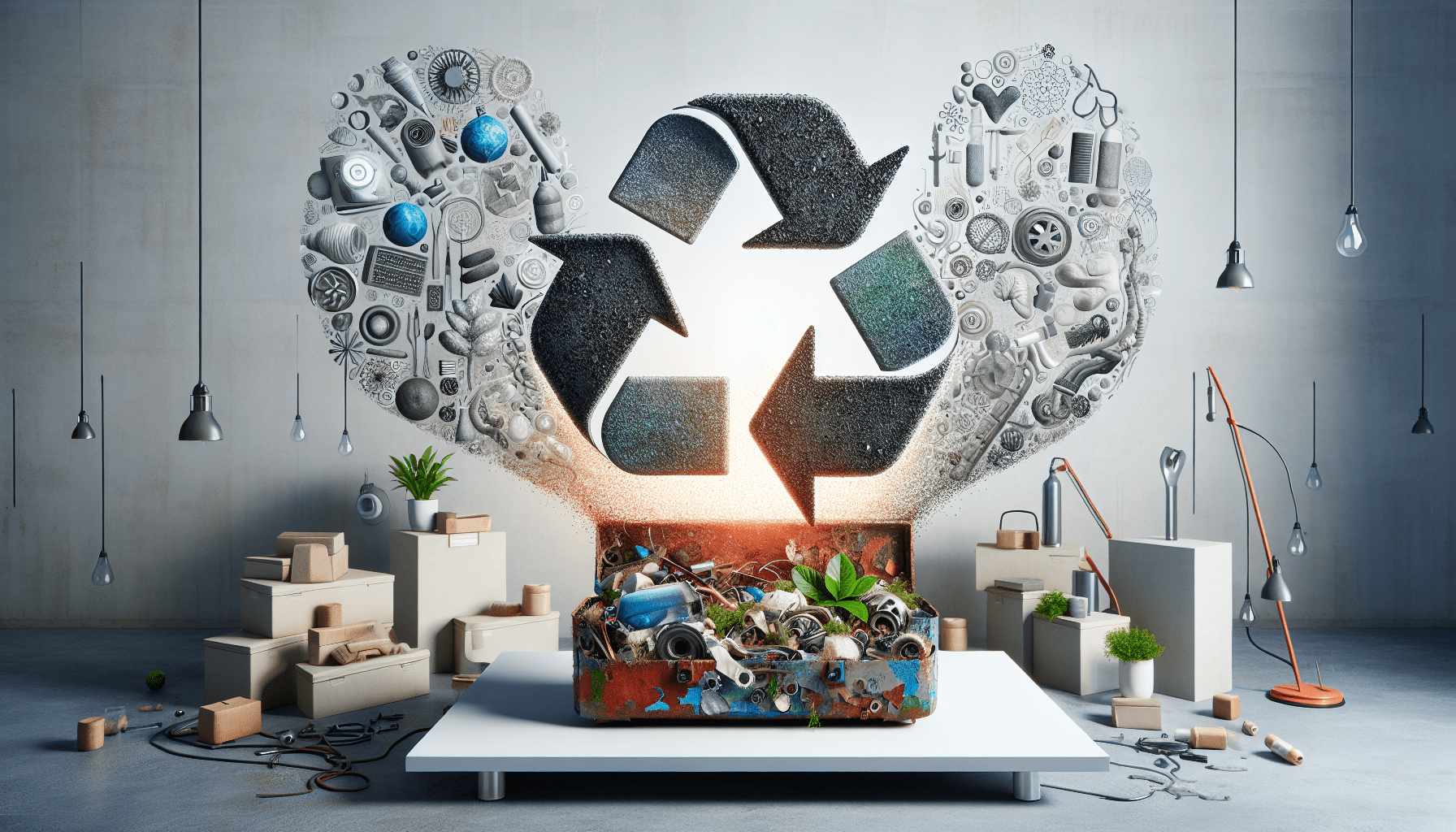Did you know that junk material, often discarded and seen as useless, actually has hidden health benefits? Discover the surprising advantages of incorporating junk material into your daily life. From boosting creativity to improving mental well-being, these hidden gems are waiting to be uncovered. So next time you come across that pile of old magazines or broken furniture, don’t dismiss it as rubbish. Instead, embrace the potential for improving your health and well-being.

Introduction
Explanation of the topic
In a world that often prioritizes new and shiny things, it’s easy to overlook the hidden potential of what may appear to be junk. However, there’s a silver lining waiting to be discovered in these discarded materials. Junk material refers to items that are often seen as useless or waste, but can actually be repurposed and reused in creative and meaningful ways. This article will explore the health benefits of finding the silver lining in junk material, from reducing waste and promoting creativity to enhancing mental health and improving physical well-being.
Importance of finding the silver lining in junk material
Finding the silver lining in junk material is vital for several reasons. Firstly, it helps reduce waste and minimize our environmental impact. By repurposing and reusing items that would otherwise end up in landfill, we can contribute to a more sustainable future. Additionally, embracing junk material encourages creativity and problem-solving skills. It stimulates our brain activity, engages our fine motor skills, and enhances our coordination and dexterity. Furthermore, junk material opens up opportunities for physical activity and exercise, leading to a healthier lifestyle. By understanding the health benefits of junk material, we can unlock its potential and make a positive impact on our well-being and the world around us.
Understanding Junk Material
Definition of junk material
Junk material encompasses a wide range of discarded items that are no longer deemed useful or valuable. It includes everyday objects, such as old furniture, broken electronics, scraps of fabric, empty containers, and more. While these items may be seen as trash by some, they hold hidden potential for repurposing and creative exploration.
Examples of common junk materials
Examples of common junk materials include cardboard boxes, plastic bottles, newspapers, old magazines, discarded wood, and unwanted clothing. These materials can be transformed into unique and functional objects with a little imagination and resourcefulness. From building structures to crafting artwork, the possibilities are endless when it comes to repurposing junk material.
Perceived negative associations with junk material
Junk material is often stigmatized due to its association with clutter, messiness, and disorganization. However, these negative perceptions fail to recognize the hidden value that junk material possesses. By embracing a new perspective and looking beyond the surface, we can uncover the infinite potential that lies within these discarded objects.
The Health Benefits of Reusing Junk Material
Reduction of waste and environmental impact
One of the primary health benefits of reusing junk material is the significant reduction of waste and environmental impact. By repurposing items that would have otherwise been thrown away, we contribute to the preservation of our planet’s resources. This promotes a healthier environment for ourselves and future generations.
Promotion of creativity and problem-solving skills
Engaging with junk material fosters creativity and problem-solving skills. When we are faced with the task of repurposing an item, we are challenged to think outside the box, come up with innovative solutions, and unleash our imagination. This process of creative problem-solving not only enhances our ability to think critically but also boosts our overall cognitive abilities.
Stimulation of brain activity and cognitive abilities
Repurposing junk material stimulates brain activity and cognitive abilities. When we engage in the process of transforming junk into something useful or aesthetically pleasing, we activate multiple areas of our brain. This engagement enhances our cognitive functions, including memory, attention, and focus, resulting in an overall improvement in our mental well-being.
Engagement of fine motor skills
Working with junk material requires the utilization of fine motor skills, such as hand-eye coordination and precision movements. Whether it’s cutting, gluing, or painting, these activities challenge and refine our fine motor skills. Regular engagement with junk material can also be particularly beneficial for individuals who need to strengthen their hand dexterity or improve their coordination.
Enhancement of coordination and dexterity
Repurposing junk material allows for the enhancement of coordination and dexterity. As we manipulate and transform various items, our hand-eye coordination improves, and our movements become more precise and controlled. This improvement in coordination and dexterity not only benefits our creative endeavors but also carries over to our daily activities, improving our overall quality of life.
Opportunities for physical activity and exercise
Engaging with junk material often involves physical activity and movement. Whether it’s collecting materials, carrying objects, or participating in DIY projects, repurposing junk can be a form of exercise in itself. This physical activity not only promotes a healthier lifestyle but also boosts our mood and overall well-being.
Junk Art Therapy
Introduction to junk art therapy
Junk art therapy is a form of creative expression that utilizes discarded materials as a medium for self-discovery, emotional release, and personal growth. By repurposing junk material, individuals can explore their feelings, express themselves visually, and reflect on their inner thoughts. Junk art therapy provides a safe and non-judgmental space for individuals to engage with their emotions and find healing through creativity.
Benefits for mental health and well-being
Junk art therapy offers numerous benefits for mental health and well-being. Engaging in the creative process allows individuals to enter a state of flow, where they can experience a sense of mindfulness and deep concentration. This state promotes relaxation, reduces stress, and enhances overall mental clarity and well-being.
Stress reduction and relaxation
Creating art with junk material can serve as a valuable stress-reduction technique. The act of transforming discarded objects into something new and meaningful can be therapeutic and calming. The repetitive motions and focused attention required in art-making help individuals enter a meditative state, relieving stress and promoting relaxation.
Expression of emotions and self-discovery
Junk art therapy provides a unique outlet for the expression of emotions and self-discovery. Repurposing junk material allows individuals to externalize their internal struggles, emotions, and experiences in a tangible and visual form. Through this process, individuals can gain insight into their thoughts, emotions, and personal narratives, facilitating self-awareness and emotional growth.
Boost in self-esteem and confidence
Engaging in junk art therapy can boost self-esteem and confidence. As individuals transform discarded materials into beautiful and meaningful creations, they experience a sense of accomplishment and pride in their abilities. This boost in self-esteem carries over into other areas of their lives, fostering a greater belief in their capabilities.
Sense of accomplishment and purpose
Junk art therapy provides individuals with a sense of accomplishment and purpose. Creating art from junk material allows them to transform something discarded into something valuable and meaningful. This process instills a sense of purpose and fulfillment, reinforcing the understanding that even seemingly insignificant objects can be repurposed and given new life.

Junk Material as Educational Tools
Integration of junk material into educational settings
Integrating junk material into educational settings offers numerous benefits for students of all ages. By incorporating junk material into lessons and activities, educators can provide hands-on learning experiences that engage students’ creativity, critical thinking, and problem-solving skills.
Enhancement of hands-on learning experiences
Junk material enhances hands-on learning experiences by providing students with the opportunity to explore and experiment with different materials. It encourages them to think innovatively, solve problems creatively, and apply their knowledge in practical ways. By engaging with junk material, students develop a deeper understanding of concepts and gain valuable skills that extend beyond the classroom.
Promotion of resourcefulness and sustainability values
By utilizing junk material in educational settings, educators promote resourcefulness and sustainability values. Students learn to value and repurpose materials rather than solely relying on new resources. This mindset fosters environmental awareness and responsible consumption habits, instilling a sense of stewardship for our planet.
Development of critical thinking and problem-solving skills
Engaging with junk material in educational settings cultivates critical thinking and problem-solving skills. By presenting students with open-ended challenges and projects, educators encourage them to think creatively, analyze situations from various perspectives, and generate innovative solutions. This process of critical thinking and problem-solving prepares students for real-world scenarios and equips them with valuable skills for their future endeavors.
Junk Material in Physical Therapy
Utilization of junk material for rehabilitation purposes
Junk material can be utilized in physical therapy settings to facilitate rehabilitation and improve motor skills. By engaging in activities that require physical movements using recycled materials, individuals undergoing physical therapy can enhance their coordination, strength, and dexterity.
Improvement of motor skills and coordination
Working with junk material in physical therapy can improve motor skills and coordination. By engaging in activities such as sorting, cutting, and assembling objects, individuals can refine their fine motor skills. These activities challenge their coordination and require precise movements, enhancing their physical abilities and promoting functional independence.
Enhancement of sensory processing abilities
Junk material can also be used to enhance sensory processing abilities in individuals undergoing physical therapy. The variety of textures, shapes, and sizes found in junk material offers opportunities for sensory stimulation, helping individuals improve their sensory integration and processing skills.
Encouragement of independent living skills
Engaging with junk material in physical therapy encourages the development of independent living skills. By using recycled materials to practice daily tasks, individuals can enhance their ability to perform self-care activities and household chores. This practical application of skills empowers individuals and promotes their overall well-being and independence.

The Importance of Mindful Consumption
Exploration of mindful consumption practices
Mindful consumption refers to a conscious and deliberate approach to consuming goods and resources. By embracing mindful consumption practices, we can reduce our reliance on new material production and make more responsible choices that benefit both our health and the environment.
Reduced reliance on new material production
Embracing mindful consumption practices reduces our reliance on new material production. By repurposing junk material and using it in our daily lives, we contribute to decreasing the demand for new resources. This reduction in consumption helps conserve natural resources, minimize pollution, and mitigate the environmental impact associated with the manufacturing process.
Encouragement of responsible consumer behaviors
Mindful consumption encourages responsible consumer behaviors and promotes a more sustainable lifestyle. By consciously choosing to repurpose and reuse items, we prioritize sustainability and minimize waste. This mindset cultivates a sense of responsibility towards our environment and fosters a culture of active participation in conservation efforts.
Economic benefits of repurposing junk material
Repurposing junk material also offers economic benefits. By finding creative uses for discarded items, we can reduce our expenses on new products. Whether it’s repurposing furniture or repurposing clothing, repurposing junk material can save money and provide unique, one-of-a-kind items without compromising quality.
Health and Safety Considerations
Precautions when repurposing junk material
While repurposing junk material can be an enjoyable and beneficial process, it is important to take certain precautions to ensure health and safety.
Avoidance of potentially harmful substances
When working with junk material, it is essential to be aware of potentially harmful substances. Some materials may contain toxic chemicals or be sharp, posing health risks. It is important to thoroughly inspect and clean junk material before use and to avoid items that could potentially cause harm.
Proper cleaning and sanitization methods
To ensure health and safety, proper cleaning and sanitization methods should be employed when repurposing junk material. Cleaning items thoroughly before use helps remove any dirt, dust, or potential contaminants. Additionally, it is essential to follow appropriate sanitation practices to prevent the spread of germs and bacteria.
Supervision and age appropriateness
When engaging in activities with junk material, it is crucial to consider age appropriateness and provide supervision when necessary. Some materials may not be suitable for young children due to sharp edges or small parts that could pose a choking hazard. Ensuring a safe environment and providing proper guidance helps prevent accidents and promotes a positive and secure experience.

Case Studies and Success Stories
Real-life examples of individuals benefiting from junk material
Numerous real-life examples showcase the tremendous benefits that can be derived from repurposing junk material. Artists, therapists, and educators have successfully incorporated junk material into their practices, resulting in positive outcomes for themselves and their communities.
Testimonials from artists, therapists, and educators
Artists, therapists, and educators have shared their success stories and testimonials regarding the benefits of repurposing junk material. These individuals have witnessed firsthand the transformative power of junk material in promoting creativity, enhancing well-being, and inspiring others. Their experiences serve as inspirational stories and encourage others to embrace the silver lining in junk.
Conclusion
Summary of the health benefits of junk material
In conclusion, finding the silver lining in junk material offers a myriad of health benefits. By repurposing and reusing discarded items, we reduce waste and minimize our environmental impact. Engaging with junk material stimulates creativity, problem-solving skills, and brain activity, enhancing our overall cognitive abilities. Junk material also plays a role in promoting mental health and well-being, as seen through the benefits of junk art therapy. Additionally, integrating junk material into educational settings enhances hands-on learning experiences and fosters resourcefulness and critical thinking skills. In physical therapy, junk material can facilitate rehabilitation and improve motor skills and coordination. Adopting mindful consumption practices reduces our reliance on new material production and encourages responsible consumer behaviors. While embracing the silver lining in junk material, it is important to prioritize health and safety considerations, ensuring proper cleaning, sanitization, and supervision. Real-life case studies and success stories serve as powerful testimonials of the positive impact that junk material can have on individuals and communities.
Encouragement to embrace the silver lining in junk
Therefore, it is essential to embrace the silver lining in junk material. By opening our minds to the potential of discarded objects, we can unlock new possibilities and contribute to a healthier and more sustainable world. So, the next time you come across what may seem like junk, remember the health benefits that lie within. Embrace the creativity, the mindfulness, and the opportunity for personal growth that repurposing junk material offers. In doing so, you can not only enrich your own life but also make a positive impact on the environment and inspire others to find their own silver lining in junk.
